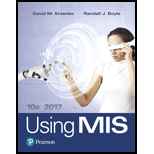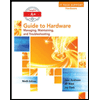
Using MIS (10th Edition)
10th Edition
ISBN: 9780134606996
Author: David M. Kroenke, Randall J. Boyle
Publisher: PEARSON
expand_more
expand_more
format_list_bulleted
Question
Chapter 4.4, Problem 5NFCQ
Program Plan Intro
Smart device:
Smart device is a device which added with extra features such as more processing power, more memory, Wi-Fi connectivity, net access, and so on.
Reason to use the smart devices:
- Nowadays, smart devices are essential. Because it is added with extra features such as more processing power, more memory, Wi-Fi connectivity, net access, and so on.
- People begin to use smart phone much than before.
- It helps to change the way of business operations.
- Business need to enhance the existing one with help of smart devices.
Expert Solution & Answer
Want to see the full answer?
Check out a sample textbook solution
Students have asked these similar questions
Considering the TM example of binary sum ( see attached)do the step-by-step of execution for the binary numbers 1101 and 11.
Feel free to use the Formal Language Editor Tool to execute it;
Write it down the current state of the tape (including the head position) and indicate the current state of the TM at each step.
I need help on inculding additonal code where I can can do the opposite code of MatLab, where the function of t that I enter becomes the result of F(t), in other words, turning the time-domain f(t) into the frequency-domain function F(s):
I need help with the TM computation step-by-step execution for the binary numbers 1101 and 11.
Formal Language Editor Tool can be used to execute it; Write it down the current state of the tape (including the head position) and indicate the current state of the TM at each step;
Chapter 4 Solutions
Using MIS (10th Edition)
Ch. 4.4 - Prob. 1NFCQCh. 4.4 - Prob. 2NFCQCh. 4.4 - Why might doctors and nutritionists be interested...Ch. 4.4 - Prob. 4NFCQCh. 4.4 - Prob. 5NFCQCh. 4.4 - Prob. 6NFCQCh. 4.6 - Prob. 1EGDQCh. 4.6 - Prob. 3EGDQCh. 4.6 - Prob. 4EGDQCh. 4.8 - Prob. 1SGDQ
Ch. 4.8 - Prob. 2SGDQCh. 4.8 - Prob. 3SGDQCh. 4.8 - Prob. 4SGDQCh. 4.8 - Prob. 4.1ARQCh. 4.8 - Prob. 4.2ARQCh. 4.8 - Prob. 4.3ARQCh. 4.8 - Prob. 4.4ARQCh. 4.8 - Prob. 4.5ARQCh. 4.8 - Prob. 4.6ARQCh. 4.8 - Prob. 4.7ARQCh. 4.8 - Prob. 4.8ARQCh. 4 - Prob. 4.1UYKCh. 4 - Prob. 4.2UYKCh. 4 - Prob. 4.3UYKCh. 4 - Prob. 4.4UYKCh. 4 - Prob. 4.5UYKCh. 4 - Prob. 4.6UYKCh. 4 - Prob. 4.7CE4Ch. 4 - Prob. 4.8CE4Ch. 4 - Prob. 4.9CE4Ch. 4 - Prob. 4.1CE4Ch. 4 - Prob. 4.11CE4Ch. 4 - Prob. 4.12CS4Ch. 4 - Prob. 4.13CS4Ch. 4 - Prob. 4.14CS4Ch. 4 - Prob. 4.15CS4Ch. 4 - Prob. 4.16CS4Ch. 4 - Prob. 4.17MMLCh. 4 - Prob. 4.18MML
Knowledge Booster
Similar questions
- Ensure you answer the question asked at the end of the document. Do not just paste things without the GNS3 console outputsarrow_forward"Do not use AI tools. Solve the problem by hand on paper only and upload a photo of your handwritten solution."arrow_forward"Do not use AI tools. Solve the problem by hand on paper only and upload a photo of your handwritten solution."arrow_forward
- "Do not use AI tools. Solve the problem by hand on paper only and upload a photo of your handwritten solution."arrow_forward"Do not use AI tools. Solve the problem by hand on paper only and upload a photo of your handwritten solution."arrow_forwardSolve this "Do not use AI tools. Solve the problem by hand on paper only and upload a photo of your handwritten solution."arrow_forward
- "Do not use AI tools. Solve the problem by hand on paper only and upload a photo of your handwritten solution."arrow_forward"Do not use AI tools. Solve the problem by hand on paper only and upload a photo of your handwritten solution."arrow_forwardSpecifications: Part-1Part-1: DescriptionIn this part of the lab you will build a single operation ALU. This ALU will implement a bitwise left rotation. Forthis lab assignment you are not allowed to use Digital's Arithmetic components.IF YOU ARE FOUND USING THEM, YOU WILL RECEIVE A ZERO FOR LAB2!The ALU you will be implementing consists of two 4-bit inputs (named inA and inB) and one 4-bit output (named out). Your ALU must rotate the bits in inA by the amount given by inB (i.e. 0-15).Part-1: User InterfaceYou are provided an interface file lab2_part1.dig; start Part-1 from this file.NOTE: You are not permitted to edit the content inside the dotted lines rectangle. Part-1: ExampleIn the figure above, the input values that we have selected to test are inA = {inA_3, inA_2, inA_1, inA_0} = {0, 1, 0,0} and inB = {inB_3, inB_2, inB_1, inB_0} = {0, 0, 1, 0}. Therefore, we must rotate the bus 0100 bitwise left by00102, or 2 in base 10, to get {0, 0, 0, 1}. Please note that a rotation left is…arrow_forward
arrow_back_ios
SEE MORE QUESTIONS
arrow_forward_ios
Recommended textbooks for you
 Principles of Information Systems (MindTap Course...Computer ScienceISBN:9781285867168Author:Ralph Stair, George ReynoldsPublisher:Cengage Learning
Principles of Information Systems (MindTap Course...Computer ScienceISBN:9781285867168Author:Ralph Stair, George ReynoldsPublisher:Cengage Learning Enhanced Discovering Computers 2017 (Shelly Cashm...Computer ScienceISBN:9781305657458Author:Misty E. Vermaat, Susan L. Sebok, Steven M. Freund, Mark Frydenberg, Jennifer T. CampbellPublisher:Cengage Learning
Enhanced Discovering Computers 2017 (Shelly Cashm...Computer ScienceISBN:9781305657458Author:Misty E. Vermaat, Susan L. Sebok, Steven M. Freund, Mark Frydenberg, Jennifer T. CampbellPublisher:Cengage Learning Fundamentals of Information SystemsComputer ScienceISBN:9781305082168Author:Ralph Stair, George ReynoldsPublisher:Cengage Learning
Fundamentals of Information SystemsComputer ScienceISBN:9781305082168Author:Ralph Stair, George ReynoldsPublisher:Cengage Learning A+ Guide to Hardware (Standalone Book) (MindTap C...Computer ScienceISBN:9781305266452Author:Jean AndrewsPublisher:Cengage Learning
A+ Guide to Hardware (Standalone Book) (MindTap C...Computer ScienceISBN:9781305266452Author:Jean AndrewsPublisher:Cengage Learning


Principles of Information Systems (MindTap Course...
Computer Science
ISBN:9781285867168
Author:Ralph Stair, George Reynolds
Publisher:Cengage Learning


Enhanced Discovering Computers 2017 (Shelly Cashm...
Computer Science
ISBN:9781305657458
Author:Misty E. Vermaat, Susan L. Sebok, Steven M. Freund, Mark Frydenberg, Jennifer T. Campbell
Publisher:Cengage Learning

Fundamentals of Information Systems
Computer Science
ISBN:9781305082168
Author:Ralph Stair, George Reynolds
Publisher:Cengage Learning

A+ Guide to Hardware (Standalone Book) (MindTap C...
Computer Science
ISBN:9781305266452
Author:Jean Andrews
Publisher:Cengage Learning